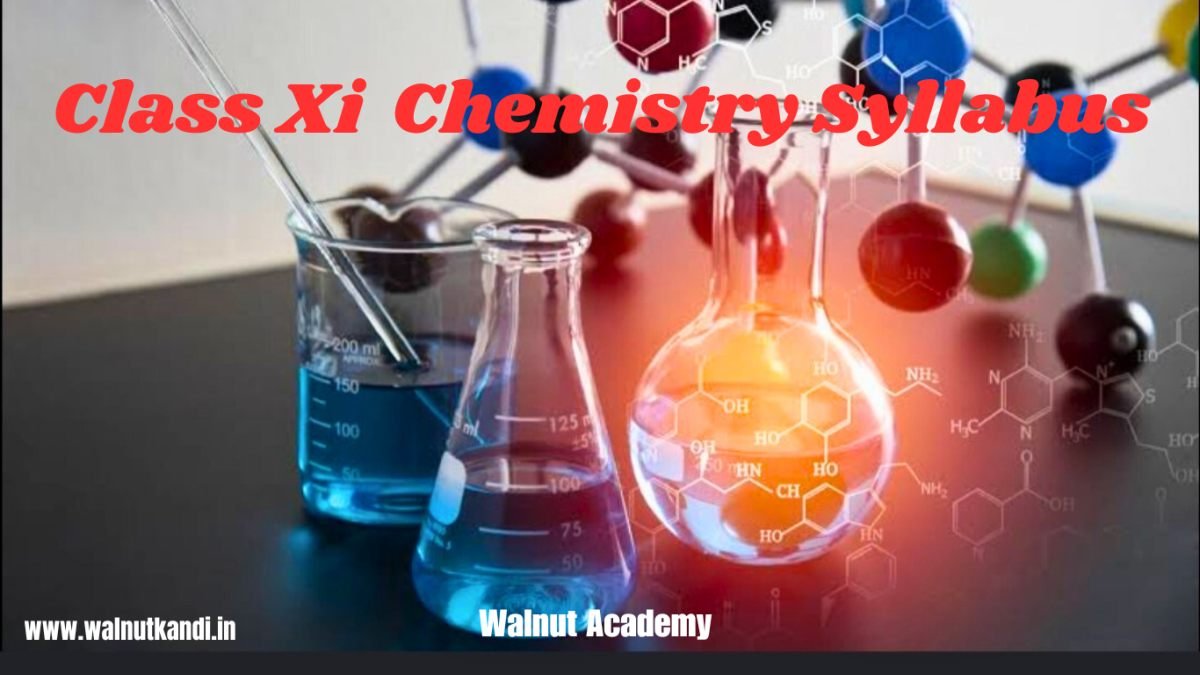It is very important topic CBSE CLASS 11 CHEMISTRY SYLLABUS PDF For Cbse Class Xi Students
Class Xi (2023-24)
F. M=70 Time – 3hours
Unit II: Solutions 10 Periods
≈Types of solutions, expression of concentration of solutions of solids in liquids, solubility of gases in liquids, solid solutions, Raoult’s law, colligative properties relative lowering of vapour pressure, elevation of boiling point, depression of freezing point, osmotic pressure, determination of molecular masses using coiligative properties, abnormal molecular mass, Van’t Hoff factor
Unit III :»Electrochemistry 12 Periods
≈Redox reactions, EMF of a cell, standard electrode potential, Nernst equation and its application to chemical cells, Relation between Gibbs energy change and EMF of a cell, conductance in electrolytic solutions, specific and molar conductivity, variations of conductivity with concentration, Kohlrausch’s Law electrolysis and law of electrolysis (elementary idea), dry cell-electrolytic cells and Galvanic cells, lead accumulator, fuel cells, corrosion.
Unit IV: Chemical Kinetics
10 period
≈Rate of a reaction (Average and instantaneous), factors affecting rate of reaction: concentration, temperature, catalyst order and molecularity of a reaction, rate law and specific rate constant,integrated rate equations and half-life (only for zero and first order reactions), concept of collisiontheory lelementary idea, no mathematical treatment), activation energy, Arrhenius equation, General introduction, electronic configuration, occurrence and characteristics of transition metals, general trends in properties of the first row transition metals-metallic character, ionization enthalpy
Unit Vill: d and f Block Elements 12 Periods
oxidation states, ionic radi, colour, catalytic property, magnetic properties, interstitial compounds,alloy formation, preparation and properties of K,CO, and KMnO4
Lanthanids – Electronic configuration, oxidation states, chemical reactivity and lanthanid contraction and its consequencesActinoids-Electronic configuration, oxidation states and comparison with lanthanids
Unit IX: Coordination Compounds12.(CBSE CLASS XI CHEMISTRY SYLLABUS PDF)
PeriodsCoordination compounds Introduction, Egands, coordination number, colour, magnetic properties and shapes, IUPAC nomenclature of mononuclear coordination compounds. Bonding Werner’stheory, VET, and CFT, structure and stereoisomerism, importance of coordination compounds (inqualitative analysis, extraction of metals and biological system)
Unit : Electrochemistry 12 Periods
Redox reactions, EMF of a cell, standard electrode potential, Nernst equation and its application tochemical cells, Relation between Gibbs energy change and EMF of a cell, conductance in electrolyticsolutions, specific and molar conductivity, variations of conductivity with concentration, Kohlrausch’sLaw, electrolysis and law of electrolysis (elementary idea), dry cell-electrolytic cells and Galvanic cells,lead accumulator, fuel cells, corrosion.
Unit IV: Chemical Kinetics 10 Periods
≈Rate of a reaction (Average and instantaneous), factors affecting rate of reaction: concentration,temperature, catalyst, order and molecularity of a reaction, rate law and specific rate constant, integrated rate equations and half-life (only for zero and first order reactions), concept of collision theory (elementary idea, no mathematical treatment), activation energy, Arrhenius equation.
Unit VII: d and f Block Elements 12 Periods
General introduction, electronic configuration, occurrence and characteristics of transition metals, general trends in properties of the first row transition metals-metallic character, ionization enthalpy.oxidation states, ionic radii, colour, catalytic property, magnetic properties, interstitial compounds,alloy formation, preparation and properties of K,Cr:O, and KMnO4
Lanthanoids – Electronic configuration, oxidation states, chemical reactivity and lanthanoidcontraction and its consequences.
Actinoids – Electronic configuration, oxidation states and comparison with lanthanolds.
Unit IX: Coordination Compounds 12 Periods (CBSE CLASS XI CHEMISTRY SYLLABUS PDF)
Coordination compounds Introduction, ligands, coordination number, colour, magnetic properties and shapes, IUPAC nomenclature of mononuclear coordination compounds. Bonding. Werner’s theory, VBT, and CFT, structure and stereoisomerism, importance of coordination compounds (in qualitative analysis, extraction of metals and biological system).
Unit X:Haloalkanes and Haloarenes 10 Periods
Haloalkanes: Nomenclature, nature of C-X bond, physical and chemical properties, optical rotation mechanism of substitution reactions.
Haloarenes: Nature of C-X bond, substitution reactions (Directive influence of halogen in monosubstituted compounds only)Uses and environmental effects of dichloromethane, trichloromethane, tetrachloromethane,ladoform, freons, DOT.
UnitXI: Alcohols, Phenols and Ethers 10 Periods
Alcohols: Nomenclature, methods of preparation, physical and chemical properties (of primary alcohols only), identification of primary, secondary and tertiary alcohols, mechanism of dehydration,uses with special reference to methanol and ethanol Phenols: Nomenclature, methods of preparation, physical and chemical properties, acidic nature ofphenol, electrophilic substitution reactions, uses of phenols.Ethers: Nomenclature, methods of preparation, physical and chemical properties, uses.
Unit XII: Aldehydes, Ketones and Carboxylic Acids
10 Periods
Aldehydes and Ketones: Nomenclature, nature of carbonyl group, methods of preparation, physical and chemical properties, mechanism of nucleophilic addition, reactivity of alpha hydrogen inaldehydes, uses.
Carboxylic Acids: Nomenclature, acidic nature, methods of preparation, physical and chemicalproperties; uses.
XIII: Amines 10 Periods
Amines: Nomenclature, classification, structure, methods of preparation, physical and chemicalproperties, uses, identification of primary, secondary and tertiary amines. Diazonium salts: Preparation, chemical reactions and importance in synthetic organic chemistry.
Unit XIV: BiomoleculesCarbohydrates –(CBSE CLASS XI CHEMISTRY SYLLABUS PDF)
Classification (aldoses and ketoses), monosaccarides (glucose and fructose), D-L configuration oligosaccharides (sucrose, lactose, maltose), polysaccharides (starch, cellulose, glycogen); Importance of carbohydrates12 PeriodsProteins-Elementary idea of -amino acids, peptide bond, polypeptides, proteins, structure of proteins -primary, secondary, tertiary structure and quaternary structures (qualitative idea only), denaturation of proteins; enzymes. Hormones – Elementary idea excluding structure.Vitamins-Classification and functions. Nucleic Acids: DNA and RNA.
CHEMISTRY (Code No. 043) QUESTION PAPER DESIGN CLASSES-XI and XII (2023-24)
| Domains | Total Marks | % |
| Remembering and Understanding: Exhibit memory of previously learned material by recalling facts, terms, basic concepts and answers. Demonstrate understanding of facts and ideas by organizing, comparing, translating, interpreting, giving descriptions and stating main ideas. | 28 | 40 |
| Applying: Solve problems to new situations by applying acquired knowledge, facts, techniques and rules in a different way. | 21 | 30 |
| Analysing, Evaluating and Creating: Examine and break information into parts by identifying motives or causes. Make inferences and find evidence to support generalizations. Present and defend opinions by making judgments about information, validity of ideas or quality of work based on a set of criteria. Compile information together in a different way by combining elements in a new pattern or proposing alternative solutions. | 21 | 30 |
Topic- Chemistry
Class -XI
Size-600 kb
Click Here To Download PDF Syllabus
CBSE BOARD official website link –Click Here








